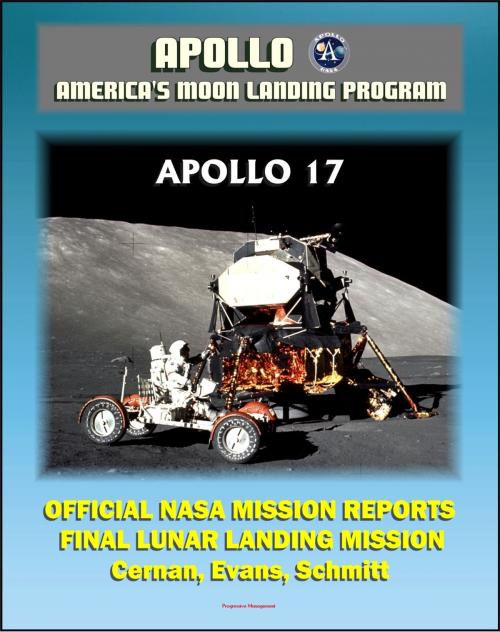Apollo and America's Moon Landing Program: Apollo 17 Official NASA Mission Reports and Press Kit - 1972 Sixth and Final Lunar Landing - Astronauts Cernan, Evans, and Schmitt
Nonfiction, Science & Nature, Science, Physics, Astronomy, History, Americas| Author: | Progressive Management | ISBN: | 9781465989604 |
| Publisher: | Progressive Management | Publication: | December 5, 2011 |
| Imprint: | Smashwords Edition | Language: | English |
| Author: | Progressive Management |
| ISBN: | 9781465989604 |
| Publisher: | Progressive Management |
| Publication: | December 5, 2011 |
| Imprint: | Smashwords Edition |
| Language: | English |
Three comprehensive official NASA documents - converted for accurate flowing-text ebook format reproduction - chronicle the flight of Apollo 17, the sixth and final Apollo lunar landing featuring the first scientist-astronaut, Harrison "Jack" Schmitt.
Two technical mission reports, the Manned Spacecraft Center (MSC) Apollo Mission Report and the NASA Headquarters Mission Operation Report (MOR), provide complete details about every aspect of the mission.
Apollo 17 MSC Mission Report: Mission description, pilots' report, communications, trajectory, command and service module performance, mission support performance, assessment of mission objectives, launch vehicle summary, anomaly summary (CSM, LM, government furnished equipment), conclusions, vehicle descriptions. Apollo 17 MOR: Mission design and execution, spacecraft performance, flight anomalies, detailed objectives and experiments, launch countdown, detailed flight mission description, back contamination program, contingency operations, configuration differences, mission support, recovery support plan, flight crew, mission management responsibility, program management, abbreviations and acronyms. Apollo 17 Press Kit: Detailed preview from countdown to landing.
At 9:15:29 a.m. GMT Dec. 7, 1972, the command and service module, or CSM, was separated from the S-IVB. Approximately 15 min later, the CSM docked with the lunar module, or LM. Landing occurred at 7:54:57 p.m. Dec. 11, at lunar latitude 20 degrees, 10 minutes north, and longitude 30 degrees 46 minutes east. Apollo 17 was the last lunar landing mission. Three extravehicular activities, or EVAs, lasted a total of 22 hours, four minutes on the lunar surface. EVA No. 1 began at 11:54:49 p.m. Dec. 11, with Eugene Cernan egressing at 12:01 a.m. Dec. 12. The first EVA was seven hours, 12 minutes long and was completed at 7:06:42 a.m. Dec. 12. The second EVA began at 11:28:06 p.m. Dec. 12, and lasted seven hours, 37 minutes, ending at at 7:05:02 a.m. Dec. 13. The final EVA began at 10:25:48 p.m. Dec. 13, and ended at 5:40:56 a.m. Dec. 14.
The LM ascent stage lifted off the moon at 10:54:37 p.m. Dec. 14. Ronald Evans performed a transearth EVA at 8:27:40 p.m. Dec. 17, that lasted one hour, six minutes, during which time he retrieved the lunar sounder film, as well as the panoramic and mapping camera film cassettes.
Apollo 17 hosted the first scientist-astronaut to land on moon: Harrison Schmitt. The sixth automated research station was set up. The lunar rover vehicle traversed a total of 30.5 kilometers. Lunar surface-stay time was 75 hours, and lunar orbit time 17 hours. Astronauts gathered 110.4 kilograms, or 243 pounds, of material.
Three comprehensive official NASA documents - converted for accurate flowing-text ebook format reproduction - chronicle the flight of Apollo 17, the sixth and final Apollo lunar landing featuring the first scientist-astronaut, Harrison "Jack" Schmitt.
Two technical mission reports, the Manned Spacecraft Center (MSC) Apollo Mission Report and the NASA Headquarters Mission Operation Report (MOR), provide complete details about every aspect of the mission.
Apollo 17 MSC Mission Report: Mission description, pilots' report, communications, trajectory, command and service module performance, mission support performance, assessment of mission objectives, launch vehicle summary, anomaly summary (CSM, LM, government furnished equipment), conclusions, vehicle descriptions. Apollo 17 MOR: Mission design and execution, spacecraft performance, flight anomalies, detailed objectives and experiments, launch countdown, detailed flight mission description, back contamination program, contingency operations, configuration differences, mission support, recovery support plan, flight crew, mission management responsibility, program management, abbreviations and acronyms. Apollo 17 Press Kit: Detailed preview from countdown to landing.
At 9:15:29 a.m. GMT Dec. 7, 1972, the command and service module, or CSM, was separated from the S-IVB. Approximately 15 min later, the CSM docked with the lunar module, or LM. Landing occurred at 7:54:57 p.m. Dec. 11, at lunar latitude 20 degrees, 10 minutes north, and longitude 30 degrees 46 minutes east. Apollo 17 was the last lunar landing mission. Three extravehicular activities, or EVAs, lasted a total of 22 hours, four minutes on the lunar surface. EVA No. 1 began at 11:54:49 p.m. Dec. 11, with Eugene Cernan egressing at 12:01 a.m. Dec. 12. The first EVA was seven hours, 12 minutes long and was completed at 7:06:42 a.m. Dec. 12. The second EVA began at 11:28:06 p.m. Dec. 12, and lasted seven hours, 37 minutes, ending at at 7:05:02 a.m. Dec. 13. The final EVA began at 10:25:48 p.m. Dec. 13, and ended at 5:40:56 a.m. Dec. 14.
The LM ascent stage lifted off the moon at 10:54:37 p.m. Dec. 14. Ronald Evans performed a transearth EVA at 8:27:40 p.m. Dec. 17, that lasted one hour, six minutes, during which time he retrieved the lunar sounder film, as well as the panoramic and mapping camera film cassettes.
Apollo 17 hosted the first scientist-astronaut to land on moon: Harrison Schmitt. The sixth automated research station was set up. The lunar rover vehicle traversed a total of 30.5 kilometers. Lunar surface-stay time was 75 hours, and lunar orbit time 17 hours. Astronauts gathered 110.4 kilograms, or 243 pounds, of material.















